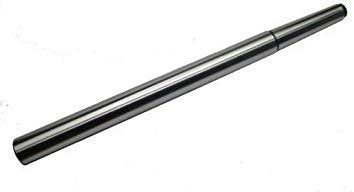- Joined
- Mar 25, 2013
- Messages
- 4,616
I agree with Tozguy. If you think you have a headstock alignment error you must take the chuck out of the equation. The only way I know to do this is with an accurate test bar bought or made on another lathe. This is a different kind of test bar than used for tailstock alignment. You cannot easily make this bar if your headstock is out of alignment. (I suppose you could if you turned between centers but I digress...) This will have an MT taper to fit your spindle and a straight shaft on the other end. Then use an indicator on the saddle to align the headstock. After that is correct you can move on to tailstock alignment.
One question that is not clear above? By "divot" do you mean "center hole" as in made by a center drill?
Robert
Like this:

$35 on Amazon
One question that is not clear above? By "divot" do you mean "center hole" as in made by a center drill?
Robert
Like this:

$35 on Amazon
Last edited:

